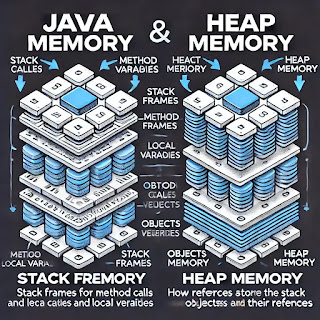Stack vs Heap Memory in Java
Introduction
Memory management is a crucial aspect of programming, and in Java, memory is divided into two main regions: Stack Memory and Heap Memory. Both these memory areas serve different purposes and are managed by the Java Virtual Machine (JVM). Understanding how they work is essential for writing efficient and optimized Java applications. In this article, we will explore the key differences between stack and heap memory, their uses, advantages, and best practices.
What is Stack Memory?
Definition
Stack memory is used for the execution of threads in Java. It stores method-specific values, local variables, and function call details. Each thread in Java has its own separate stack memory.
Characteristics of Stack Memory
- Fast Access: Stack memory is much faster than heap memory.
- Automatic Deallocation: Memory is deallocated automatically when a method completes execution.
- Limited Size: Stack memory is smaller compared to heap memory.
- Thread-Specific: Each thread has its own stack, preventing shared access issues.
- Stores Primitive Data and References: It holds method calls, local primitive variables, and references to objects in the heap.
How Stack Memory Works?
- When a method is invoked, a new block (stack frame) is added to the stack.
- Local variables and method parameters are stored in this stack frame.
- When the method completes execution, the stack frame is removed, freeing memory.
- The last allocated stack frame is always the first to be removed (LIFO – Last In, First Out).
Example of Stack Memory Usage
public class StackMemoryExample {
public static void main(String[] args) {
int a = 10;
int b = 20;
int result = sum(a, b);
System.out.println("Sum: " + result);
}
public static int sum(int x, int y) {
return x + y;
}
}
How Stack Works Here:
main()method is pushed onto the stack.sum()method is called, creating a new stack frame.- Once
sum()completes execution, its stack frame is removed. main()method finishes execution, and its stack frame is also removed.
What is Heap Memory?
Definition
Heap memory is used for dynamic memory allocation, where objects are stored during runtime. Unlike stack memory, objects in the heap are managed by the Garbage Collector (GC).
Characteristics of Heap Memory
- Slower than Stack: Heap memory is accessed via pointers, making it slower.
- Shared Memory: All threads share the same heap memory.
- Larger in Size: Heap memory is significantly larger than stack memory.
- Garbage Collected: Objects remain in the heap until they are garbage collected.
- Dynamic Allocation: Objects are allocated memory dynamically at runtime.
How Heap Memory Works?
- Objects are created using the
newkeyword. - The JVM allocates memory in the heap and returns a reference stored in stack memory.
- Garbage Collector removes unreferenced objects to free space.
Example of Heap Memory Usage
class HeapMemoryExample {
String name;
public HeapMemoryExample(String name) {
this.name = name;
}
public static void main(String[] args) {
HeapMemoryExample obj1 = new HeapMemoryExample("Object 1");
HeapMemoryExample obj2 = new HeapMemoryExample("Object 2");
System.out.println(obj1.name);
System.out.println(obj2.name);
}
}
How Heap Works Here:
HeapMemoryExampleobjects are stored in heap memory.obj1andobj2references are stored in stack memory.- When the program finishes execution, objects may be garbage collected.
Stack vs Heap Memory: Key Differences
| Feature | Stack Memory | Heap Memory |
|---|---|---|
| Speed | Fast | Slower |
| Memory Size | Small | Large |
| Access | LIFO (Last In, First Out) | Random Access |
| Thread Safety | Each thread has its own stack (Thread-safe) | Shared across threads |
| Lifetime | Exists till method execution | Exists till Garbage Collector removes it |
| Storage | Stores local variables, method calls | Stores objects and instance variables |
| Management | Automatically managed | Managed by Garbage Collector |
Common Mistakes and Best Practices
Common Mistakes
-
Exceeding Stack Size (StackOverflowError)
- Occurs due to deep recursion or infinite recursion.
- Example:
public class StackOverflowExample { public static void recursiveMethod() { recursiveMethod(); } public static void main(String[] args) { recursiveMethod(); } }- Solution: Use iterative approaches instead of deep recursion.
-
Memory Leaks in Heap
- Holding unnecessary object references prevents GC from reclaiming memory.
- Example:
import java.util.ArrayList; class MemoryLeakExample { static ArrayList<String> list = new ArrayList<>(); public static void main(String[] args) { while (true) { list.add("Memory Leak"); } } }- Solution: Always remove unused references (
list.clear()).
Best Practices
✅ Use local variables whenever possible instead of instance variables. ✅ Avoid creating unnecessary objects inside loops. ✅ Set objects to null when no longer needed. ✅ Use WeakReference or SoftReference for cache objects. ✅ Optimize recursive calls with Tail Recursion or Iterative solutions.
Conclusion
Understanding stack vs heap memory is crucial for writing optimized Java applications. While stack memory is fast and used for method execution, heap memory is dynamic and used for object storage. Both play a vital role in Java’s memory management, and by following best practices, developers can avoid performance issues like StackOverflowError and memory leaks.
By mastering stack and heap memory management, Java developers can write efficient, scalable, and high-performing applications. 🚀
Sign up here with your email

ConversionConversion EmoticonEmoticon